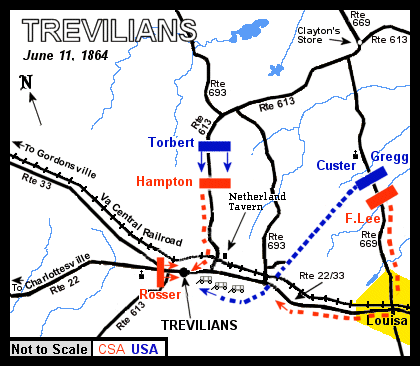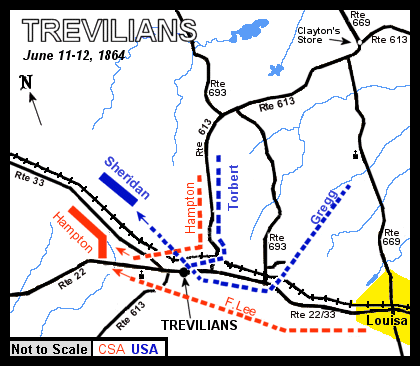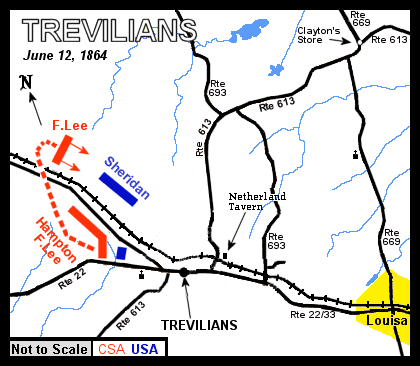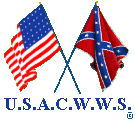
|
U. S. CIVIL WAR
PHOTOGRAPHS
|

|
THE BATTLE OF
TREVILIAN STATION
(PAGE 1 OF 2)


Trevilian Station - 2001
During the War it was on the far side of the
railroad tracks which run behind it today.
In the text, the icon  is a link to the definition of the word it marks. is a link to the definition of the word it marks.
Use your browser's "back" button to return to this page.
| |
Date: June 11-12, 1864
Estimated Casualties : 1,600 total : 1,600 total
To draw off the Confederate cavalry and open the
door for a general movement to the James River, Union General U.S. Grant ordered
Maj. Gen. Philip Sheridan to make a diversionary raid toward Charlottesville.
He was to take two division and open the
door for a general movement to the James River, Union General U.S. Grant ordered
Maj. Gen. Philip Sheridan to make a diversionary raid toward Charlottesville.
He was to take two division of cavalry and
tear up as much of the Virginia Central Railroad as came within his grasp, then
push on to Charlottesville and unite with Major General David Hunter, and 18,000
men. Together, the two would advance on Richmond from the west, while U.S. Grant
enveloped of cavalry and
tear up as much of the Virginia Central Railroad as came within his grasp, then
push on to Charlottesville and unite with Major General David Hunter, and 18,000
men. Together, the two would advance on Richmond from the west, while U.S. Grant
enveloped the city from the
south. the city from the
south.

Railroad tracks behind Trevilian Station, looking west - 2001
As noted above, the station (on your left) was moved across the tracks
after the war. During the war it would have been on the viewer's right.
Sheridan left the Army of the Potomac on June 7th and headed west up the North Anna River toward
Trevilian Station (The town is now called "Trevilians" or "Trevillians"). He took
with him the mounted divisions of Brigadier Generals Alfred T.A.Torbert
and David McM. Gregg, totaling 8,000 men, 24 guns, and 125 wagons.
on June 7th and headed west up the North Anna River toward
Trevilian Station (The town is now called "Trevilians" or "Trevillians"). He took
with him the mounted divisions of Brigadier Generals Alfred T.A.Torbert
and David McM. Gregg, totaling 8,000 men, 24 guns, and 125 wagons.
Confederate General Robert E. Lee sent the cavalry divisions of Major Generals
Wade Hampton and Fitzhugh Lee in pursuit of Sheridan on June 9th. Hampton had
overall command of the 5,000-man force.
Traveling by a shorter route than that used by Sheridan, Hampton reached the
Trevilian area on June 10, one day ahead of the Union column. Fitzhugh Lee
bivouacked at Louisa Court
House, a few miles east of Trevilian. at Louisa Court
House, a few miles east of Trevilian.
Rather than stand on the defensive, Hampton planned to attack the Federals at
their camp , located at
Clayton's Store. Two main roads ran from Clayton's Store to the railroad. One
met the railroad at Trevilian Station and the other met the railroad at Louisa
Court House. Thick woods lay between them. Hampton took the first road, and Lee
the second. , located at
Clayton's Store. Two main roads ran from Clayton's Store to the railroad. One
met the railroad at Trevilian Station and the other met the railroad at Louisa
Court House. Thick woods lay between them. Hampton took the first road, and Lee
the second.

Trevilian Station Battlefield Map, June 11, 1864
Early on June 11th, Hampton engaged portions of Torbert's division and pushed him
back up the road toward Clayton's Store. At the same time, Fitzhugh Lee
encountered Gen. George A. Custer's brigade on the Louisa Court House road. When
Lee fell back after contacting Custer, he created a dangerous gap between
himself and Hampton. Custer exploited the gap and captured Hampton's wagon
train, 800 horses, and three cassions parked behing the Confederate lines.
When Hampton learned that Custer had gained his rear, he ordered Gen. Thomas
Rosser's brigade to attack Custer.
Rosser's charge sent the Union horsemen reeling. Other Confederate brigades
joined the attack, forcing Custer to give up his spoils and take a defensive
position around Trevilian Station. to attack Custer.
Rosser's charge sent the Union horsemen reeling. Other Confederate brigades
joined the attack, forcing Custer to give up his spoils and take a defensive
position around Trevilian Station.
To relieve Custer, Sheridan attacked Hampton forcing the Confederate general to
retreat to a point several miles west of Trevilian station. Fitzhugh Lee
meanwhile fell back to Louisa Court House.

Trevilian Station Battlefield Map, June 11-12, 1864
During the night of the 11th, Hampton posted his division in an angled line
covering the railroad west of Trevilian. The railroad embankment covered his
left flank while open ground
in front of his position offered an excellent field of fire. Fitzhugh Lee joined
Hampton by noon the next day, reinforcing his right flank. while open ground
in front of his position offered an excellent field of fire. Fitzhugh Lee joined
Hampton by noon the next day, reinforcing his right flank.

Trevilian Station Battlefield Map, June 12, 1864
After spending the morning of the 12th destroying five miles of railroad track,
Sheridan moved out to attack Hampton. Time and again the dismounted Federals charged
the Confederate line only to be repulsed. However, Hampton's situation was
getting critical. He was nearly out of ammunition, Union artillery Federals charged
the Confederate line only to be repulsed. However, Hampton's situation was
getting critical. He was nearly out of ammunition, Union artillery raked portions of
his line, and Union sharpshooters picked off officers and enlisted men from the
vantage point of a barn situated near the front. However, the Confederates
persevered. By late afternoon additional ammunition reached the front. At the
same time, Confederate artillery silenced the offending Federal battery raked portions of
his line, and Union sharpshooters picked off officers and enlisted men from the
vantage point of a barn situated near the front. However, the Confederates
persevered. By late afternoon additional ammunition reached the front. At the
same time, Confederate artillery silenced the offending Federal battery and set fire to
the barn that housed the annoying sharpshooters. and set fire to
the barn that housed the annoying sharpshooters.
An attack by Fitzhugh Lee against Sheridan's right flank late in the day,
brought the battle to a close. At 10 p.m. Sheridan broke off the fight and
returned to the Army of the Potomac, having failed to unite with Hunter or
inflict any permanent damage to the railroad. Sheridan lost
735 men; Confederate losses, although not precisely known, probably numbered
around 1,000. This was one of the bloodiest cavalry battles of the war.
(Text Source: U.S. Gov't, National Park Service and The Trevilian Station
Brochure)

Road Sign
|
|
PAGE TWO
 >
Civil War Photos
> Trevilian Station
>
Page 2
>
Civil War Photos
> Trevilian Station
>
Page 2
|
|










